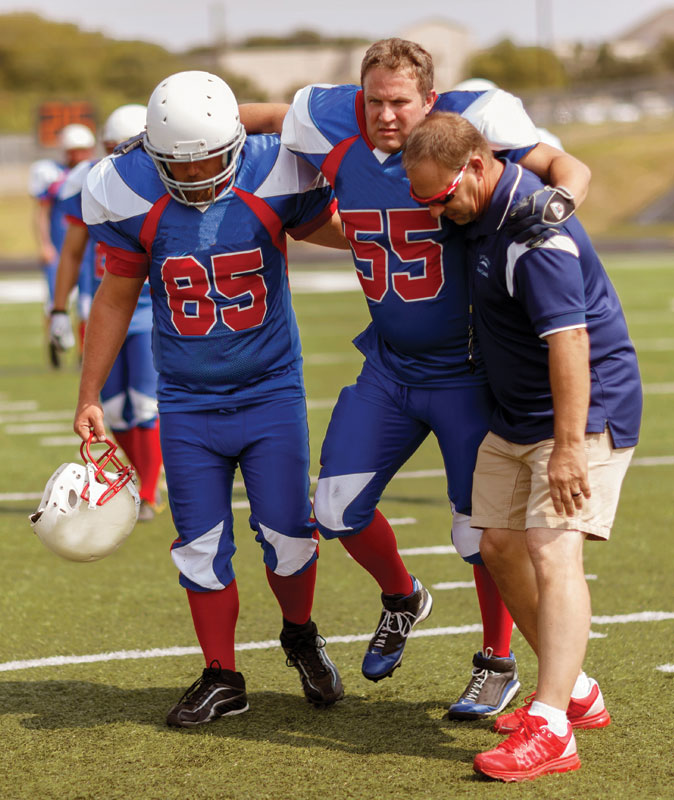Managing a High Ankle Sprain
Historically, research has told us that high ankle sprains (HAS) make up one to 18% of all ankle sprains. However, more recent literature suggests that in athletics, almost half of all ankle sprains show symptoms above the classic ankle joint. If you’ve been an athletic trainer for any length of time, you’ve seen your share of them.
Ankle sprains that cause proximal tenderness above the ankle joint, involve injury to the syndesmosis, and do not show signs of fracture or diastasis (joint widening) usually fall under the category of HAS. They are frequently missed and often diagnosed in retrospect when the ankle just doesn’t progress as anticipated. They may be associated with chronic pain, prolonged disability, recurrent ankle sprains, and heterotopic ossification (HO) — the formation of bone tissue outside of the skeleton.
HAS are generally caused by hyperpronation, excessive dorsiflexion or plantar flexion, or when another athlete falls onto an externally rotated, fixed ankle from behind. Some of the more recent research indicates that athletes who suffer a significant inversion injury coupled with axial loading may also injure their syndesmosis. Understanding HAS requires a thorough knowledge of syndesmotic anatomy and biomechanics. The ankle syndesmosis is the articulation between the tibia and fibula just above the classic ankle joint and it contains dense fiberous tissue that helps to stabilize the ankle. The tibia and fibula grip the square-shaped talus much like a wrench gripping a nut. The syndesmosis acts like the adjustment nut on the wrench. When it is injured, it does not allow for proper ankle function. One study showed that a 1-millimeter widening of the syndesmosis decreased weight-bearing ability by 42%. Syndesmotic stability is the key to ankle function.
Understanding HAS requires a thorough knowledge of syndesmotic anatomy and biomechanics. The ankle syndesmosis is the articulation between the tibia and fibula just above the classic ankle joint and it contains dense fiberous tissue that helps to stabilize the ankle. The tibia and fibula grip the square-shaped talus much like a wrench gripping a nut. The syndesmosis acts like the adjustment nut on the wrench. When it is injured, it does not allow for proper ankle function. One study showed that a 1-millimeter widening of the syndesmosis decreased weight-bearing ability by 42%. Syndesmotic stability is the key to ankle function.
Assessment & Diagnosis
Acute or sideline evaluation should include notation of any obvious swelling or discoloration. When present, the swelling is usually quite distinctive and above the classic ankle joint. Of particular importance is tibial/fibular tenderness, which may indicate a fracture. An easy test to check for boney pain or syndesmotic tenderness is the Squeeze Test. Squeeze the lower leg at mid-calf and note any fibular grating or syndesmotic pain. Grating may be a sign of fracture or a more significant injury.
Performing a valgus stress test (stress at 90 degrees) at mid-calf may also be beneficial to rule out a more serious injury. Palpation should be done along the entire length of the tibia and fibula, particularly along the medial and lateral malleolus. Palpation of the deltoid, anterior tibiofibular ligament (AITFL), and posterior talofibular ligament (PITFL) is also important for identifying any injured ligaments.
Have the injured athlete bear weight, then continue a progression from two-legged toe raises to single-leg toe raises to single-leg hops from the toes. If the athlete is able to hop from their toes without letting their heel touch the ground upon landing, a more significant syndesmotic injury can be ruled out. Inability to do a single-leg hop may be predictive of syndesmotic injury or irritation.
Loss of ROM and ambulatory functional ability should also be noted. And palpation of the foot, lower leg, medial and lateral ligament structures, as well as superficial syndesmotic ligaments, membranes, and bones should be completed.
There are quite a few different clinical tests that can be performed to identify a HAS. For each of the following, compare ankles bilaterally. Though these tests do not gauge the extent of a ligamentous injury, when positive, they are indicative of injury and irritation.
→ Modified Kleiger test: Stabilize the lower leg, then move the foot into dorsiflexion and external rotation. Note any pain with motion.
→ Cotton test: Stabilizing the lower leg, firmly grasp the calcaneus and medially/laterally rock the talus within the ankle joint. Note any pain with motion.
→ Fibular distraction: Utilize anterior/posterior force. Note any pain with motion. Tape test: Compare ankle motion and function while un-taped, then with tape wrapped tightly around the lower leg in a banded fashion. Have the athlete raise up on their toes and/or walk. Note any improvement in function while banded.
Athletic trainers may find it helpful to measure the extent of proximal tenderness by using a tenderness measurement. This measurement may be completed by measuring from the distal tip of the fibula to the most proximal point of pain. The measurement should be done in centimeters and it may be useful in predicting disability. The longer the tenderness measurement, the longer the prognosis is for recovery.
Treatment Tips
Unfortunately, HAS does not respect elaborate tape jobs, expensive braces, or extensive treatment. There is no one-size-fits-all conclusive management protocol for HAS. While one athlete may need to sit out of play for just a week, another may need months of rehab. The key is to develop a unique rehab program for each athlete that follows a three-stage progression from acute care, to sub-acute care, to long-term management of the injury.
→ Acute Care: During the acute phase of care, the goals should be to protect the injured joint, reduce pain and swelling, maintain neuromuscular pathways, and limit ROM loss. In order to meet the first goal of protecting the injured joint, clinicians frequently utilize complete immobilization in a cast, boot, or splint.
Immobilization can be beneficial for protecting the injured joint and allowing healing to take place, but it can also be detrimental to neuromuscular function and loss of motion. Choice of immobilization method should take individual, structural, and treatment concerns into consideration. A removable appliance would seem most appropriate so that therapy and modalities may be utilized to treat inflammation and avoid disuse atrophy. Though the acute phase of care generally lasts only four to seven days, immobilization can last anywhere from a few days to several weeks.
It is beneficial for the ankle to undergo daily modalities and therapy to reduce edema, address pain, and facilitate guarded motion within a safe range (-20 degrees of plantar flexion to 10 degrees of dorsiflexion). Resistance exercises with a towel or therapy band that involve light, passive dorsiflexion stretching should be encouraged.
Resistance exercises can be done for plantar flexion and dorsiflexion within the safe zone of motion. Care should be given to minimize extreme plantar flexion and dorsiflexion as the fibula moves distally, posteriorly, and rotates around a vertical axis. Extreme motion would stress the injured structures of the syndesmosis and should be discouraged acutely. Inversion and eversion exercises should be limited in the initial phase of rehabilitation.
→ Sub-acute Care: The sub-acute phase should address increasing function, improving strength and proprioception, and normalizing gait. During this phase, therapy should increase in demand and intensity only as tolerated by the athlete.
This is a key period of recovery as too much activity will perpetuate chronic ankle pain and tenderness over the AITFL, and can create a painful cycle of disability. Close attention needs to be paid daily by the athletic trainer to limit overuse. Ideally, this is the transition time to greater function and return to play.
Range of motion exercises should increase beyond 30 degrees of safe motion. Resistance training within a greater ROM can also be increased. Biking may be added with the seat high to minimize dorsiflexion. Low-level proprioceptive exercises should be initiated and progressed as tolerated. Here are some examples of proprioceptive exercises:
- Weight-bearing: Have the athlete stand on two legs and progress to weight-bearing on the injured side.
- Weight shifts: Have the athlete shift his or her weight from side to side and front to back.
- Heel-toe walking: Ask the athlete to walk in a straight line with each step connecting lead heel to trail toe.
- Balance exercises: Have the athlete start by balancing on the injured leg, then progress to bending at the waist while standing on the leg, and finally progress to balancing on the injured leg with eyes closed.
- Single-leg hop to balance: Ask the athlete to hop from non-injured to injured leg, catch, and balance.
Long-Term Care
The third and final stage of returning from a HAS is long-term management. Unfortunately, chronic disability, pain, dysfunction, and HO are commonly associated with HAS, and the disability associated with the injury can range from days to months. Under-recognizing the injury and perpetuating an athlete’s desire to “push through” the injury will prolong their recovery and can contribute to chronic disability, so long-term care is paramount.
Athletes may return to play when they can pass the single-leg hop test from their toes, cut at high speed without a noticeable limp, and very importantly, only when they are mentally ready to return. This can be determined by their willingness to tackle tougher drills in their rehab process. Patients will be subject to re-injury and chronic pain if they are not able to perform these functional tasks.




